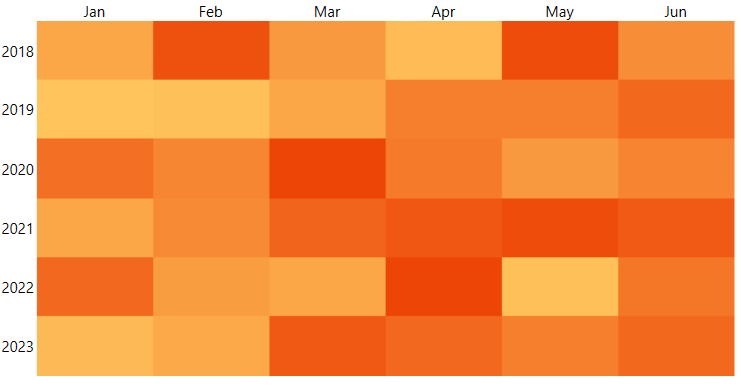Getting Started with Silverlight HeatMap
This tutorial will walk you through the creation of a sample application that contains RadHeatMap with a categorical definition.
Assembly References
In order to use RadHeatMap, you will need to add references to the following assemblies:
- Telerik.Windows.Controls
- Telerik.Windows.Controls.DataVisualization
- Telerik.Windows.Data
You can find the required assemblies for each control from the suite in the Controls Dependencies help article.
Setting up the Data
To use the RadHeatMap control you will need to define a model that will describe the data that will be shown.
Example 1: Defining the model
public class TempInfo
{
public int Year { get; set; }
public string Month { get; set; }
public double Temperature { get; set; }
}
Setting up the Control
The control works with few different definitions that describe how to data will be shown. In this example we will use the CategoricalDefinition. The definition provides few properties to define what data should be used.
The RowGroupMemberPath property contains the name of the property in the custom model that will be used to generate the rows.
The ColumnGroupMemberPath property contains the name of the property in the custom model that will be used to generate the columns.
The ValuePath property contains the name of the property in the custom model that will be used to generate the cells. Based on that value the cell will be colored differently.
To populate the control with data use its ItemsSource property.
Example 2: Defining the heatmap
<telerik:RadHeatMap>
<telerik:RadHeatMap.Definition>
<telerik:CategoricalDefinition x:Name="categoricalDefinition"
RowGroupMemberPath="Year"
ColumnGroupMemberPath="Month"
ValuePath="Temperature" />
</telerik:RadHeatMap.Definition>
</telerik:RadHeatMap>
Example 3: Creating the data and setting the ItemsSource
private void PrepareData()
{
int year = 2018;
string[] months = new string[6] { "Jan", "Feb", "Mar", "Apr", "May", "Jun" };
var randomNumberGenerator = new Random();
var source = new ObservableCollection<TempInfo>();
for (int i = 0; i < months.Length; i++)
{
for (int k = 0; k < 6; k++)
{
var info = new TempInfo() { Year = year + k, Month = months[i], Temperature = randomNumberGenerator.Next(10, 300) };
source.Add(info);
}
}
this.categoricalDefinition.ItemsSource = source;
}
Figure 1: RadHeatMap

Colorization
The heatmap control has a built-in colorizer that sets the color of each cell based on the plotted value. You can change the colors as you like by defining a new colorizer. You can read more about this in the Colorizers article.